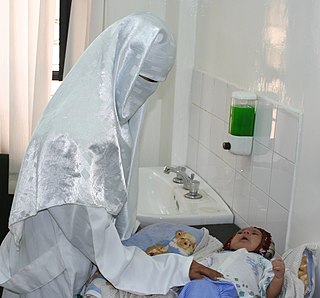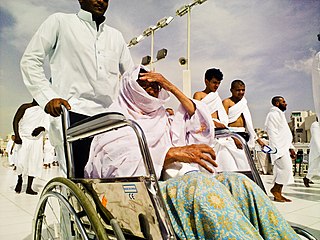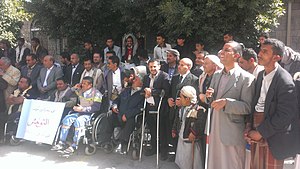
Disability is the experience of any condition that makes it more difficult for a person to do certain activities or have equitable access within a given society. Disabilities may be cognitive, developmental, intellectual, mental, physical, sensory, or a combination of multiple factors. Disabilities can be present from birth or can be acquired during a person's lifetime. Historically, disabilities have only been recognized based on a narrow set of criteria—however, disabilities are not binary and can be present in unique characteristics depending on the individual. A disability may be readily visible, or invisible in nature.

The Houthi insurgency, also known as the Houthi rebellion, the Sa'dah War, or the Sa'dah conflict, was a military rebellion pitting Zaidi Shia Houthis against the Yemeni military that began in Northern Yemen and has since escalated into a full-scale civil war. The conflict was sparked in 2004 by the government's attempt to arrest Hussein Badreddin al-Houthi, a Zaidi religious leader of the Houthis and a former parliamentarian on whose head the government had placed a $55,000 bounty.
Prostitution in Yemen is illegal and punishable by penalty from 3 years of prison to even death penalty but common especially in Aden and in the capital, Sana'a. UNAIDS estimate there are 54,000 prostitutes in the country. Many of these women have turned to prostitution because of poverty. Many are Ethiopian and Somali refugees.

Yemen is an Islamic society. Nearly all Yemenis are Muslims, with approximately 60% belonging to Sunni Islam and 40% belonging to Shia Islam (Zaidi). Amongst the native population, there were approximately 1,000 Christians, and 6 remaining Jews in 2016. However, Pew-Templeton estimates the number of Christians to be as high as 40,000, though most do not publicly identify as such, due to fears of religious persecution. According to WIN/Gallup International polls, Yemen has the most religious population among Arab countries and it is one of the most religious populations world-wide.

Women in Yemen have historically been placed at a disadvantage due to their gender, with a highly patriarchal society. Although the government of Yemen has made efforts that will improve the rights of women in Yemen, many cultural and religious norms, along with poor enforcement of this legislation from the Yemeni government, have prevented Yemeni women from having equal rights to men.
The world's poor are significantly more likely to have or incur a disability within their lifetime compared to more financially privileged populations. The rate of disability within impoverished nations is notably higher than that found in more developed countries. Since the early 2010s there has been growing research in support of an association between disability and poverty and of a cycle by which poverty and disability are mutually reinforcing. Physical, cognitive, mental, emotional, sensory, or developmental impairments independently or in tandem with one another may increase one's likelihood of becoming impoverished, while living in poverty may increase one's potential of having or acquiring disability in some capacity.
Disability in China is common, and according to the United Nations, approximately 83 million people in China are estimated to have a disability.
Northern Ireland has differing legislation and policy in relation to disability than in other areas of the UK, due to the various governmental powers and competencies that are devolved to the Northern Ireland Assembly.
Jamala al-Baidhani was a Yemeni activist who supported civil rights for women and disabled people. She is the founder of the Al-Tahadi Association for Disabled Females, the first group in Yemen devoted to helping girls with disabilities.
The overall prevalence of people with disabilities is 4.52% of the population, i.e., 63.28 million, according to the ICMR's publication from the NFHS-5 survey 2019-21. India is a party to the United Nations Convention on the Rights of Persons with Disabilities. Legislation that affects people with disabilities in India includes the Rights of Persons with Disabilities Act, 2016, the Mental Health Care Act, 2017, the National Trust Act, 1999, and the Rehabilitation Council of India Act, 1992. People with disabilities in India are faced with negative social attitudes in the wider population.
Peruvians with disabilities constitute 5.2% of the population. 52.1% of disabled people are women. 40.5% of disabled Peruvians have a primary or better education. 76.8% are not economically active they have an unemployment rate of 12.1%. Of those Peruvians with disabilities who do work, 58.3% are self-employed.

Murad Subay is a Yemeni contemporary artist, street artist and a political activist who has launched several street art campaigns of which society engagement marked one of their important elements. He first started to paint on the streets after the revolution of 2011, in a campaign he called "Color the Walls of Your Street".
Disability affects many people in Zimbabwe in both rural and urban areas. In spite of services provided by the government, philanthropists and welfare agencies, people with disabilities and their families often face several barriers. Philanthropist, Jairos Jiri, started services for people with disability in Zimbabwe in the 1940s. He is regarded as the father or founder of disability work in Zimbabwe.

Disability in Saudi Arabia is seen through the lens of Islamic Sharia, through cultural norms and also through legislation. As an Islamic society that follows the Qur'an and the Sunnah, disability is often seen through the lens of religion. Islam teaches that people with disabilities are to be treated with respect and equality. However, Saudi Arabia tends to view disability through the medical model, rather than the social model. In addition, there are few studies relating to people with disabilities in Saudi Arabia compared to other countries.

Singapore does not have a formal definition of disability. Singapore signed on to the Convention on the Rights of Persons with Disabilities in 2013 and coordinates the Enabling Masterplan with both government and non governmental organisations.

People with disability in Zambia face many unique challenges. The country has been passing laws and policies to help people with disabilities in Zambia, however, social stigma and other factors sometimes interfere in people being able to access services and assistance. In addition, the HIV epidemic in Zambia also has a significant impact on the lives of people with disabilities.

Approximately 12 million French citizens are affected by disability. The history of disability activism in France dates back to the French Revolution when the national obligation to help disabled citizens was recognized, but it was "unclear whether or not such assistance should be public or private." Disabled civilians began to form the first associations to demand equal rights and integration in the workforce after the First World War. Between 1940 and 1945, 45,000 people with intellectual disabilities died from neglect in French psychiatric asylums. After the Second World War, parents of disabled children and charities created specialized institutions for disabled children for whom school was not accessible. In 2018, the French Government began to roll out a disability policy which aimed to increase the allowance for disabled adults to €900 per month, improve the digital accessibility of public services, and develop easy-to-read and understand language among other goals.
The 2016 National Disability Survey found that there are approximately 2,683,400 people with disabilities in South Korea. Physical disabilities account for about 50% of the total disabled population. In the past few decades, guided by the five-year plan, policies and services related to people with disabilities have improved. The government has established several regional rehabilitation centers for people with disabilities and has provided and implemented rehabilitation programs in their communities. The number of disabled people in South Korea is increasing as the population ages. Regarding this matter, the South Korean government is planning a stable welfare model to adapt to long-term demographic changes.

People with disability in Algeria are protected under the law. Algeria has adopted the Convention on the Rights of Persons with Disabilities and the Arab Charter on Human Rights. Algeria is working to make the country more accessible to people with disabilities. Overall, about 2.5 percent of the country has some type of disability with men having a higher rate of disability than women.










